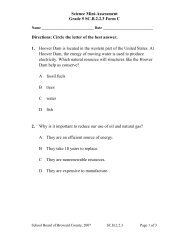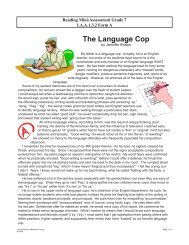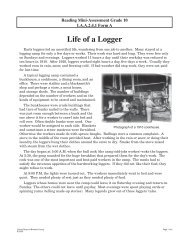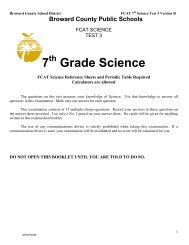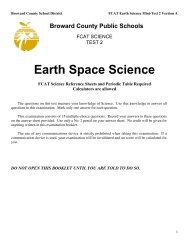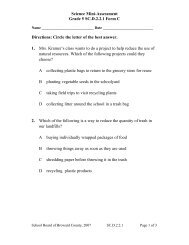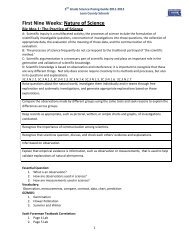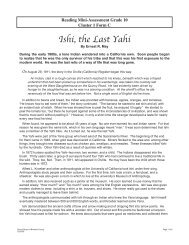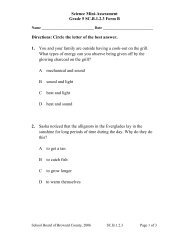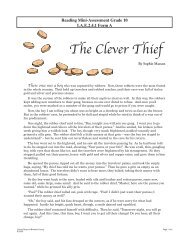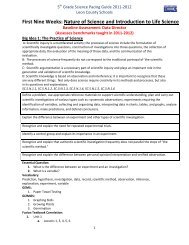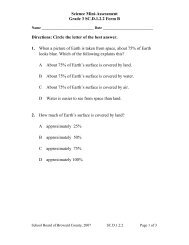Reading Mini-Assessment Grade 8 LA.A.1.3.2 Form B
Reading Mini-Assessment Grade 8 LA.A.1.3.2 Form B
Reading Mini-Assessment Grade 8 LA.A.1.3.2 Form B
You also want an ePaper? Increase the reach of your titles
YUMPU automatically turns print PDFs into web optimized ePapers that Google loves.
<strong>Reading</strong> <strong>Mini</strong>-<strong>Assessment</strong> <strong>Grade</strong> 8<br />
<strong>LA</strong>.<strong>A.1.3.2</strong> <strong>Form</strong> B<br />
quantities of salt that dissolve easily in the water.<br />
Rain or melting snow releases this salt and carries it<br />
into streams. Great Salt Lake is fed by three rivers,<br />
as well as several small streams and springs. In most<br />
lakes, salt is carried out as fast as it is brought in,<br />
keeping the water fresh, but Great Salt Lake has no<br />
outlet. Evaporation takes water out of the lake, but<br />
the salt stays.<br />
In dry years more water evaporates, and the<br />
lake shrinks and becomes saltier. During wet<br />
cycles, the lake grows and the water is less salty.<br />
Over the last century, Great Salt Lake has averaged<br />
25 percent salt. Ocean water is only 3 percent salt.<br />
Because the water is so salty, companies harvesting<br />
at Great Salt Lake can make salt faster and cheaper<br />
than those using ocean water. Great Salt Lake is<br />
not a beautiful, picture-postcard mountain lake. At<br />
first glance the landscape seems empty and barren.<br />
There are no trees on the shore, and to the west<br />
stretches an immense salt desert. The water itself<br />
is another kind of desert. Nothing but algae and<br />
brine shrimp can survive such a salty bath.<br />
But despite its barren appearance, the lake<br />
is far from dead. Its islands and marshes provide<br />
an important rest stop for migratory birds. The<br />
mouth of the Bear River, where Jim Bridger drifted<br />
into the lake, is a protected bird refuge. Over 200<br />
different species have been identified there as they<br />
travel between North and South America. Millions<br />
of brine flies living by the shore provide plenty of<br />
food. Some birds–California sea gulls, ducks, geese,<br />
and pelicans—return every summer to build nests<br />
and raise their young at Great Salt Lake.<br />
Without the sea gulls, Salt Lake City might<br />
have become a deserted ghost town. Food was<br />
scarce the first year after the pioneers hauled their<br />
wagons over the Rocky Mountains to the isolated<br />
valley. Trekking back to St. Louis for supplies took<br />
months, and without a good harvest, the settlers<br />
faced starvation. Their newly planted acres of<br />
wheat and corn looked promising. But one day,<br />
clouds of black crickets poured out of the foothills.<br />
They blanketed the fields, gorging on the tender<br />
green plants. The farmers tried to pick the bugs off,<br />
beat them, or even burn them, but it was useless.<br />
The insects swarmed across the valley, destroying<br />
everything in their path.<br />
Suddenly, large flocks of sea gulls appeared<br />
from their nesting grounds at the lake. The farmers<br />
watched in horror. Surely the birds would finish<br />
up anything the crickets missed. But instead of<br />
joining the destruction, the gulls began scooping<br />
up crickets. They returned time and time again,<br />
devouring the insects. Enough of the crop was<br />
saved for the settlers to survive another winter.<br />
That’s why the state of Utah honors the California<br />
sea gull as its official state bird.<br />
From that first small settlement in the valley,<br />
the population has expanded so that now more<br />
than a million people live north, south, and east<br />
of the lake. Urban growth has had little effect on<br />
Great Salt Lake, though. It is a unique geological<br />
feature and an unmistakable landmark on the map<br />
of the western United States.<br />
“America’s Saltiest Sea: Great Salt Lake,” reprinted by permission of Cricket Magazine, April 1996, Vol. 23, No. 8, © 1996 by Angela B. Haight, illustrations from the Utah Division of Wildlife.<br />
School Board of Broward County Page 2 of 4<br />
8/15/08




